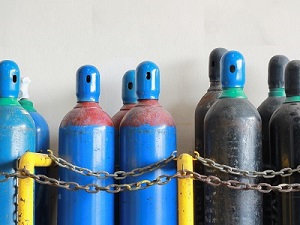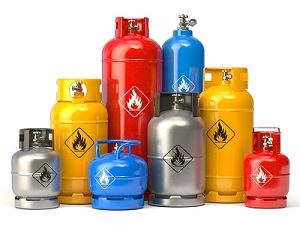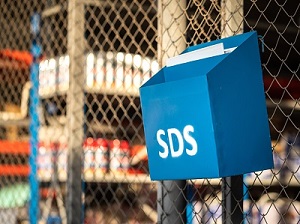Hazardous materials are found in most workplaces but do all employees understand the risks?

Hazardous materials serve valuable functions in the workplace like the flammable liquids used for cutting and welding or the compressed gas used to fuel forklifts. It’s critical that workers know about the hazardous materials in their work area.
- The vapors from flammable liquids can ignite at normal working temperatures.
- Compressed gases and liquefied petroleum gases (LPG) are under high pressure posing both fire and explosion risk.
OSHA Standard 1910.106(b)(6) "Sources of ignition." In locations where flammable vapors may be present, precautions shall be taken to prevent ignition by eliminating or controlling sources of ignition. Sources of ignition may include open flames, lightning, smoking, cutting and welding, hot surfaces, frictional heat, sparks (static, electrical, and mechanical), spontaneous ignition, chemical and physical-chemical reactions, and radiant heat.
Compressed Gases are under high pressure and may contain dangerous gases that can affect your health in unsafe conditions. Some types of compressed gases commonly found in workplaces include:
- Acetylene – for fueling cutting torches
- Argon – welding
- Freon – refrigeration coolant
- Oxygen – welding, metal cutting
To prevent injury and accidents, compressed gas cylinders must be used, stored, and transported properly.
- Do not smoke, have open flames, or use spark-producing equipment around compressed gas containers.
- Inspect regulators, cylinders and cylinder valves of compressed gas containers regularly to ensure safe operation.
- Gases that may react with each other must be stored separately.
- Do not vent flammable gases indoors.
- When not in use, ensure bottles/cylinders are chained or locked in an upright position with caps securely in place.
OSHA Standard 1910.253(b)(2)(ii) Inside of buildings, cylinders shall be stored in a well-protected, well-ventilated, dry location, at least 20 feet from highly combustible materials such as oil or excelsior. Cylinders should be stored in definitely assigned places away from elevators, stairs, or gangways. Assigned storage spaces shall be located where cylinders will not be knocked over or damaged by passing or falling objects, or subject to tampering by unauthorized persons. Cylinders shall not be kept in unventilated enclosures such as lockers and cupboards.

There are two primary hazards associated with Flammable Liquids: Explosions and Fire.
Flammable liquids commonly found in the workplace include:
- Acetone – solvent
- Benzene – plastics manufacturing
- Carbon Disulfide – cellophane manufacturing
- Gasoline – fuel
- Hexane – textile manufacturing, glue production
- Isopropanol – solvent, cleaning fluid
- Methanol – antifreeze, solvent, fuel
- Toluene – solvent, explosives manufacturing
OSHA Standard 1910.106(d)(5)(i) "Egress." flammable liquids, including stock for sale, shall not be stored so as to limit use of exits, stairways, or areas normally used for the safe egress of people.
- Flammable liquids must only be stored in proper, approved containers that are labeled correctly.
- Flammable liquids should be stored in approved cabinets (commonly referred to as a fire cabinet).
- Exits, stairways and doors shall not be blocked by flammable liquid containers.
- In areas where flammable liquids and/or vapors may be present, employees must not smoke, light matches, perform hot work, or have an open flame.

Liquified Petroleum Gas (LPG), also referred to as propane or butane, is a flammable mixture of hydrocarbon gases used as fuel for heating, cooking and to power heavy equipment like forklifts. LPG is an odorless liquid that evaporates into a gas and is extremely flammable.
Hazards of LPG include:
- When LPG gas meets a source of ignition it can burn or explode.
- If involved in a fire, LPG cylinders can explode.
- LPG can cause cold burns to the skin if direct contact is made to the liquified gas.
OSHA Standard 1910.110(b)(6)(i) ) Containers, and first stage regulating equipment if used, shall be located outside of buildings, except… [when used in designated locations and in] LP-Gas fueled industrial trucks…
- Always store LPG cylinders upright, in well-ventilated areas, and ensure they are not at risk of tipping over in their storage location.
- Do not store LPG cylinders near flammable liquid containers or oxidizing gases (like Oxygen).
- Keep the LPG cylinder valves closed when not in use.
- Only use LPG if the container is in good condition, free from damage and rust. The hoses and appliance fittings should also be in good condition.

Every hazardous material that is or may be used in the workplace should have its own Safety Data Sheet (SDS) that is easily accessible by all employees in a common area, like a Right to Know Center. Each SDS includes information such as:
- the properties of the chemical
- the physical, health and environmental health hazards
- protective measures
- safety precautions for handling, storing and transport
Refer to Section 8 of the SDS to find recommendations for personal protective equipment (PPE) that should be worn to prevent illness or injury from exposure to the chemical and any special requirements for the PPE, like a specific type of glove or respirator.

Hazardous Materials is one safety meeting topic you don't want to skip! Employees may not have had experience working with or near the hazardous materials found in the workplace and going over the basics a few times a year is always a good idea.
.jpg)

.jpg)